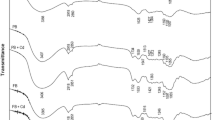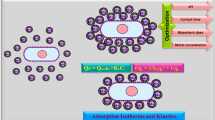Abstract
Ruppia maritima and Echinodorus amazonicus were prepared in a dehydrated powder form. The characteristics and mechanisms of adsorption of heavy metals were studied under various pH values, reaction times, and heavy metal ion concentrations. The results showed that under different pH and reaction time conditions, heavy metal adsorption was lead > cadmium > zinc > copper. The adsorption of lead increased linearly with the lead concentration. For cadmium, zinc and copper, the adsorption was saturated when metal ion concentration exceeded 200 mg/L. When a Freundlich model was applied, R 2 values for the heavy metal adsorption by the aquatic plants mostly exceeded 0.9. The adsorption of heavy metal ions by these two aquatic plant powders was better explained by the Lagergren second-order equation than the first-order equation. From the Fourier Transform Infrared spectra, there was an adsorption peak at 2,115 cm−1 for R. maritima. The peak shape did not change with metal affiliation except there was a shift of peak wavelength before adsorption. The results indicate that the mechanism of heavy metal adsorption by the two species is not simply on the mono-molecular layer level, and that intra-particulate dispersal is the dominant process. Heavy metal pollution does not affect the basic chemical components, and major substances involved in heavy metal adsorption including carbohydrates, cell wall pectin, and protein functional groups.




Similar content being viewed by others
References
Ahmad MK, Islam S, Rahman S, Haque MR, Islam MM (2010) Heavy metals in water, sediment and some fishes of Buriganga River. Bangladesh Int J Environ Res 4(2):321–332
Amir S, Hafidi M, Merlina G, Hamdi H, Revel JC (2004) Elemental analysis, FTIR, 13CNMR of humic acids from sewage sludge composting. Agronomie 24:13–18
APHA, AWWA, WEF (1998) Standard methods for the examination of water and wastewater (20th edn). American Public Health Association, American Water Works Association and the Water Environment Federation. Washington, DC, USA
Chang CY, Tsai WT, Ing CH (2003) Adsorption of polyethylene glycol (PEG) from aqueous solution onto hydrophobic zeolite. J Coll Interf Sci 260(2):273–279
Dizadji N, Abootalebi Anaraki N, Nouri N (2011) Adsorption of chromium and copper in aqueous solutions using tea residue. Int J Environ Sci Tech 8(3):631–638
Du Y, Fei Lian, Zhu LY (2011) Biosorption of divalent Pb, Cd and Zn on aragonite and calcite mollusk shells. Environ Pollut 159(7):1763–1768
Febrianto J, Kosasih AN, Sunarso J, Ju YH, Indraswati N, Ismadji S (2009) Equilibrium and kinetic studies in adsorption of heavy metals using biosorbent: a summary of recent studies. J Hazard Mater 162:616–645
Göbel P, Dierkes C, Coldewey WG (2007) Storm water runoff concentration matrix for urban areas. J Contam Hydrol 91:26–42
Gupta VK, Rastogi A (2008) Sorption and desorption studies of chromium (VI) from nonviable cyanobacterium Nostoc muscorum biomass. J Hazard Mater 154:347–354
Ho YS, Mckay G (1999) Pseudo-second order model for sorption processes. Proc Biochem 34(5):451–465
Ho YS, Mckay G (2000) The kinetics of sorption of divalent metal ions onto Sphagnum moss peat. Water Res 34(3):735–742
Ibrahim WM (2011) Biosorption of heavy metal ions from aqueous solution by red macroalgae. J Hazard Mater 192:1827–1835
Ikem A, Adisa S (2011) Run off effect on eutrophic lake water quality and heavy metal distribution in recent littoral sediment. Chemosphere 82:259–267
Kansanen PH, Venetvaara J (1991) Comparison of biological collectors of airborne heavy metals near ferrochrome and steel works. Water Air Soil Pollut 60(3–4):337–359
Kazuo N (2009) Theory and applications in inorganic chemistry. In: John WS (ed) Infrared and Raman Spectra of inorganic and coordination compounds. Wiley Liss Inc., Canada
Kim YH, Kim CM, Choi IH, Rengaraj S, Yi JH (2004) Arsenic removal using mesoporous alumina prepared via a templating method. Environ Sci Tech 38(3):924–931
Macfie SM, Welbourn PM (2000) The cell wall as a barrier to uptake of metal ions in the unicellular green alga Chlamydomonas reinhardtii (Chlorophyceae). Arch Environ Contam Toxicol 39(4):413–419
Martins RJE, Pardo R, Boaventura RAR (2004) Cadmium (II) and zinc (II) adsorption by the aquatic moss Fontinalis antipyretica: effect of temperature, pH and water hardness. Water Res 38(3):693–699
Miretzky P, Saralegui A, Cirelli AF (2006) Simultaneous heavy metal removal mechanism by dead macrophytes. Chemosphere 62:247–254
Ng JCY, Cheung WH, Mckay G (2003) Equilibrium studies for the sorption of lead from effluents using chitosan. Chemosphere 52(6):1021–1030
Niu H, Xu XS, Wang JH, Volesky B (1993) Removal of lead from aqueous solutions by Penicillium biomass. Biotechnol Bioeng 42(6):785–787
Pan XL, Wang JL, Zhang DY (2005) Biosorption of Pb(II) by Pleurotus ostreatus immobilized in calcium alginate gel. Process Biochem 40(8):2799–2803
Pearson RG (1990) Hard and soft acids and bases—the evolution of a chemical concept. Coord Chem Rev 100:403–425
Preetha B, Viruthagiri T (2005) Biosorption of zinc by Rhizopus arrhizus: equilibrium and kinetic modeling. Afr J Biotech 4(6):506–508
Ramiro JEM, Rui ARB (2002) Uptake and release of zinc by aquatic bryophytes (Fontinalis antipyretica L. ex. Hedw.). Water Res 36(20):5005–5012
Reza R, Singh G (2010) Heavy metal contamination and its indexing approach for river water. Int. J. Environ. Res 7(4):785–792
Saeed A, Iqbal M, Akhtar MW (2005) Removal and recovery of lead (II) from single and multimetal (Cd, Cu, Ni, Zn) solutions by crop milling waste (black gram husk). J Hazard Mater 117(1):65–73
Seader JD, Henly EJ (2006) Separation process principles, 2nd edn. John Wiley and Sons Inc., New York
Vazque G, Gonzalez AJ, Garcia AL, Freire MS, Antorrena G (2007) Adsorption of phenol on formaldehyde-pritreated Pinus pinaster bark: equilibrium and Kinetics. Bioresour Technol 98(8):1535–1540
Vinodhini V, Das N (2010) Relevant approach to assess the performance of sawdust as adsorbent of chromium (VI) ions from aqueous solutions. Int. J. Environ. Sci. Tech 7(1):85–92
Yu B, Zhang Y, Shukla A, Shukla S, Dorris KL (2001) Removal of heavy metals from aqueous solution by sawdust adsorption of lead and comparison of its adsorption with copper. J Hazard Mater 84(1):83–94
Yu LL, Gai LG, Cui DL, Wang QL (2009) In-situ investigation of BBr3/benzene solution by Fourier transformation infrared spectroscopy. Chem Res Chinese U 25(5):733–737
Zvinowanda CM, Okonkwo JO, Shabalala PN, Shabalala PN, Agyei NM (2009) A novel adsorbent for heavy metal remediation in aqueous environments. Int J Environ Sci Tech 6(3):425–434
Acknowledgments
The present research was supported by National Nature Science Fund (No.30700111), “948” project of Ministry of Water Resources of P. R. China (No. 201007), and The Public Service Sectors Research Fund of Ministry of Water Resources of P. R. China (No. 201001021).
Author information
Authors and Affiliations
Corresponding author
Rights and permissions
About this article
Cite this article
Deng, P.Y., Liu, W., Zeng, B.Q. et al. Sorption of heavy metals from aqueous solution by dehydrated powders of aquatic plants. Int. J. Environ. Sci. Technol. 10, 559–566 (2013). https://doi.org/10.1007/s13762-013-0186-3
Received:
Revised:
Accepted:
Published:
Issue Date:
DOI: https://doi.org/10.1007/s13762-013-0186-3




